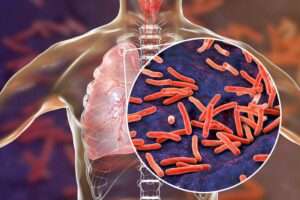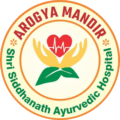Tuberculosis

Introduction:
Tuberculosis, known as Raajyakshma or Kshayaroga in Ayurveda, is a common disorder prevalent in slum areas, primarily affecting individuals with weakened immune systems. Spread through various methods like air droplets, it often remains undiagnosed due to the absence of major symptoms. This chronic disease progresses slowly, leading to a weakened body system and, if left untreated, can be fatal. Early diagnosis is crucial for effective management.
Ayurvedic Viewpoint on Tuberculosis:
In Ayurveda, tuberculosis has four types and several subtypes. It is caused by the bacteria Mycobacterium Tuberculosis, which can be transmitted through various methods, including air droplets. Individuals with weakened immune systems, such as those working in infectious areas, people with immune disorders like AIDS, and those with sudden weight loss or excessive workload, are prone to tuberculosis.
A. Pathogenesis in Ayurveda:
According to Ayurveda, tuberculosis occurs when individuals with weak immunity are exposed to tuberculosis bacteria. This leads to a disturbance in the three doshas, causing their accumulation in joints, vessels, or any system. Improper functioning of the respiratory system hampers circulation, resulting in a weakened body. Reduced circulation leads to an overload on digestion, resulting in low hunger, weight loss, and eventually, the manifestation of tuberculosis.
B. Prodromal Signs of Tuberculosis:
Before the actual onset of the disease, prodromal signs may include frequent cold, increased salivation, fatigue, body ache, reduced hunger, and other symptoms. Rapid growth of nails and hair is observed due to disrupted Dhatu production.
C. Signs and Symptoms of Tuberculosis:
Common signs and symptoms of tuberculosis include
- Reduced Hunger and Weight: Individuals with tuberculosis often experience a significant loss of appetite, leading to weight loss.
- Extreme Fatigue: Tuberculosis can cause profound fatigue, leaving individuals feeling excessively tired and lacking energy.
- Evening Fever: A distinctive characteristic of tuberculosis is the occurrence of mild to moderate fever, typically more pronounced in the evening.
- Cough: Persistent coughing is a common symptom, and it may be accompanied by the production of phlegm or blood in severe cases.
- Backache: Tuberculosis may lead to discomfort or pain in the back, contributing to overall physical distress.
- Change in Voice: Some individuals may experience a change in their voice quality, which can be attributed to the impact of tuberculosis on the respiratory system.
- Reduced Sense of Taste: Tuberculosis can affect the sensory perception, leading to a diminished sense of taste, impacting the enjoyment of food.
- Disturbed Sleep: Sleep disturbances, such as insomnia or frequent waking during the night, can be associated with tuberculosis.
- Decreased Mental Activities: Cognitive functions may be affected, resulting in a reduction in mental activities, including difficulty concentrating or remembering.
These signs and symptoms collectively indicate the presence of tuberculosis, emphasizing the importance of early detection and intervention for effective management of the disease.
Ayurvedic Treatment on Tuberculosis:
1. Curability in Ayurveda:
Tuberculosis is completely recoverable in Ayurveda under specific circumstances, emphasizing the potential for successful treatment.
2. Medicinal Treatments:
Ayurvedic medicines are designed to address various aspects of tuberculosis, including:
- Increasing Hunger (e.g., pippali, shunthi)
- Enhancing Physical Power (e.g., Ashwagandha, Chyavanprash)
- Maintaining Dosha Balance (e.g., Guduchi)
- Strengthening the Respiratory System (e.g., Rasyan)
3. Ayurvedic Therapies:
Various Ayurvedic therapies are employed based on the patient’s condition. These include:
- Panchakarma: A comprehensive detoxification process.
- Snehan: Oleation therapy involving the application of medicated oils.
- Swedan: Inducing sweat through herbal steam therapy.
- Shirodhara: Pouring a continuous stream of oil on the forehead.
- Nasya: Nasal administration of medicated oils.
- Dhumapaan: Herbal smoking therapy.
- Udvartan: Dry powder massage to stimulate circulation.
- Upnaah: Therapeutic bandaging to support healing.
These tailored therapies aim to address the specific condition of the patient, providing a holistic approach to tuberculosis treatment in Ayurveda. It is essential to seek guidance from an Ayurvedic physician for personalized advice and a structured treatment plan.
Diet and lifestyle modification for Tuberculosis:
A. Dietary Recommendations:
- Balanced Diet: Emphasize a well-balanced diet incorporating a variety of whole foods, including fruits, vegetables, whole grains, and lean proteins. Include foods rich in vitamins and minerals to support overall health.
- Herbal Infusions: Consumption of herbal infusions with immune-boosting properties, such as ginger and tulsi (holy basil), can be beneficial.
- Digestive Support: Include easily digestible foods to support a healthy digestive system. Use digestive spices like cumin, coriander, and fennel in meals.
- Avoidance of Unhealthy Foods: Limit the intake of processed foods, refined sugars, and unhealthy fats. Avoid foods that may cause indigestion or bloating.
- Hydration: Ensure an adequate intake of water and herbal teas to stay hydrated.
B. Lifestyle Modifications:
- Adequate Rest: Prioritize sufficient rest and quality sleep to support the body’s healing process.
- Moderate Exercise: Engage in moderate, non-strenuous exercises, as recommended by Ayurvedic practitioners.
- Fresh Air and Sunlight: Spend time outdoors in fresh air and sunlight, promoting overall well-being.
- Stress Management: Adopt stress management techniques such as meditation and deep breathing to reduce stress levels.
- Personal Hygiene: Maintain personal hygiene practices to prevent the spread of infections.
- Avoidance of Smoking and Alcohol: Quit smoking and limit or avoid alcohol consumption.
- Regular Follow-up: Regularly follow up with an Ayurvedic physician for monitoring and adjustments to the treatment plan.
Yoga in Tuberculosis:
A. Yoga Asana:
- Tadasana (Mountain Pose): Promotes lung expansion and overall body alignment.
- Trikonasana (Triangle Pose): Stretches and strengthens the lungs and chest.
- Bhujangasana (Cobra Pose): Opens up the chest and aids in deep breathing.
- Marjarasana (Cat-Cow Pose): Enhances spinal flexibility and promotes gentle movement in the chest.
- Setu Bandhasana (Bridge Pose): Strengthens the chest muscles and improves lung capacity.
- Sukhasana (Easy Pose): Encourages a comfortable seated position for breathing exercises.
- Baddha Konasana (Bound Angle Pose): Opens up the chest and promotes relaxation.
- Surya Namaskar (Sun Salutation): A series of poses that engage the entire body and encourage controlled breathing.
- Paschimottanasana (Seated Forward Bend): Stretches the spine and encourages deep breathing.
- Ustrasana (Camel Pose): Opens up the chest and promotes lung expansion.
- Vrikshasana (Tree Pose): Focuses on balance and stability while encouraging deep breaths.
- Matsyasana (Fish Pose): Expands the chest and stimulates the respiratory system.
B. Pranayama:
- Anulom Vilom (Alternate Nostril Breathing): Anulom Vilom helps balance the flow of energy in the body and supports respiratory health.
- Bhramari (Bee Breath): Bhramari involves the production of a humming sound during exhalation, promoting calmness and relaxation.
- Kapalbhati (Skull Shining Breath): Kapalbhati is an invigorating breathing technique that cleanses the respiratory system.
Precautions:
- Always consult with your healthcare provider before incorporating yoga and pranayama into your routine, especially if you have a pre-existing medical condition.
- Avoid strenuous poses and exercises that may cause fatigue or strain.
- Practice under the guidance of a qualified yoga instructor who is aware of your health condition.
Uniqueness of Ayurvedic Therapies:
At Arogya Mandir – Shri Siddhanath Ayurvedic Hospital, Miraj, patients undergo a detailed examination using noninvasive Ayurvedic diagnostic tools. Therapies are prescribed based on the exact pathogenesis of the disease, resulting in early and effective outcomes. The unique therapies include silent, clean therapy rooms, trained therapists, positive environments, appropriate selection of massage oils, free Prakruti and Dhatu Sarata examinations, authentic procedures, and the use of herbal medicines.
Share this article for free.
[Copyright message – This article is published on drchivateayurved.org by Dr. Prashant Chivate. This article is made for information about disease. Any other use of this article is strictly prohibited. All rights reserved.]
